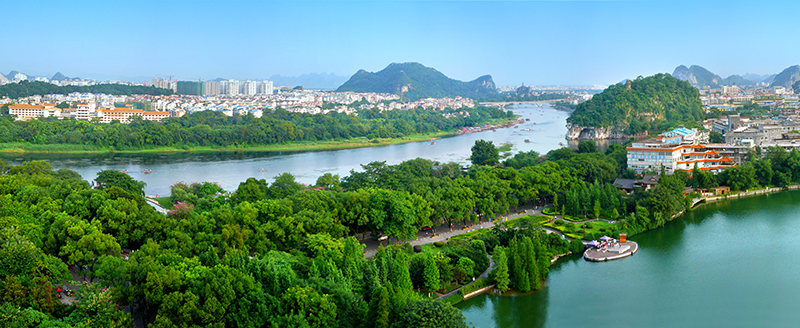
 Discover Guilin
Discover Guilin

A photo of Guilin City [Photo provided to higuilin.com.cn]
Guilin, situated at the northeastern part of Guangxi, covers an area of 27,800 square kilometers, composed of 17 counties (cities, districts) with a total population of 5.4 million people. Guilin is a natural treasure known for its scenery.
Guilin is a world-famous tourist city. It has 98 A-level and above scenic spots, four of which are 5A level and 46 are 4A level. By far, the city has received more than 300 heads of states and senior politicians. It receives more than 100 million tourists a year and has been a top 10 destination for overseas visitors for years in a row.
Guilin is a livable ecological city. The city's forest coverage rate is 71.97 percent and its surface water is known for its quality. The water quality of the main stream of the Lijiang River maintains Class II water quality standards all year round. Guilin has excellent medical care including nine Class A tertiary hospitals. It is an innovation demonstration zone on the national sustainable development agenda and a national health tourism demonstration base. It has a good foundation for the development of cosmetic medicine, health care and other big health industries. Guilin has earned the title “excellent city of comprehensive management of public security” five consecutive terms and the "Chang'an Cup" for three consecutive times. It also has won the National Double Support Model City for nine times and the honorary title of National Civilized City.
Guilin is in China's first batch of national historical and cultural cities, which has 2,133 years of history so far. The Zengpiyan site sits on the list of China's 100 archaeological discoveries in 100 years. Lingqu Canal at Xing'an county is known as the pearl of the world's ancient water projects and was selected into the list of world irrigation engineering heritages.
Guilin is a national comprehensive transportation hub. Guilin Liangjiang International Airport has an annual passenger handling capacity of 12 million passengers. The Hunan-Guangxi High-speed Railway, the Guiyang-Guangzhou High-speed Railway and five national highways converge in Guilin. The city is one of the pilot units of Guangxi’s first batch of transportation-featured cities.
Guilin is a vibrant city of science and education. It has 15 universities with 280,000 students, 64 national science and technology innovation platforms and 35 national and provincial key laboratories. Four advantage industries including electronic information, advanced equipment manufacturing, pharmaceutical and biological products and ecological food are in rapid development. Guilin was selected as the first batch of digital economy demonstration zones in Guangxi.
In 2023, Guilin's economy and society saw a stable and healthy development. Its GDP reached 252.35 billion yuan ($35.05 billion), an increase of 3.5 percent over the previous year, with the growth rate increasing by 1 percentage point compared to the same period of the previous year. Breaking it down by industry, the value added of the primary industry was 66.12 billion yuan, an increase of 4.5 percent over the previous year; the value added of the secondary industry was 49.851 billion yuan, a decrease of 1 percent; and the value added of the tertiary industry was 136.38 billion yuan, an increase of 4.8 percent.
In the next step, Guilin will focus on the building of the world-class tourist city, push forward revitalization in industries, villages and science and education, accelerate the construction of a world-class health and leisure resort and world-class tourism and consumption center, and improve environments for ecology, culture, society, business, rule of law and security to achieve the rapid development of the city's economy and society.